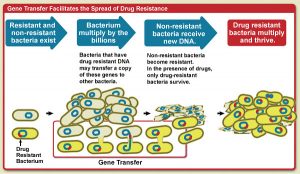
What is Antimicrobial resistance?
Antimicrobial resistance (AMR) is the ability of a microorganism to stop an antimicrobial (such as antibiotics, antivirals and antimalarials) from working against it. As a result, standard treatments become ineffective, infections persist and may spread to others.[1] The World Health Organisation (WHO) has described AMR as an increasingly serious threat to global public health. [2]
Although antibiotic resistance develops naturally in bacteria, human actions can increase resistance developing and spreading. This can happen:
- When health professionals over prescribe antibiotics,
- When antibiotics are prescribed for a viral infection,
- When people don’t take antibiotics as directed e.g. don’t finish the course of antibiotics,
- Due to poor hygiene and a lack of infection prevention and control e.g. not washing hands properly
- Due to people travelling around the world, spreading resistant bacteria.[3]
AMR in China:
Sadly, the crisis of antimicrobial resistance is worsening and has become a major public safety problem in China.[4] To try to overcome this problem, China has issued a 2016-2020 One Health National Action Plan to Contain Antimicrobial Resistance with 14 ministries to ensure a clear multi-sectoral approach.[5] However, it is not only humans that can have problems with AMR but farm animals too. Farm animals in northeast China are becoming more resistant to common antimicrobial drugs.[6]
AMR in the EU:
AMR is responsible for an estimated 33,000 deaths per year in the EU and it costs the EU EUR 1.5 billion per year in healthcare costs and productivity losses.[7] In fact, the health burden of infections due to bacteria with AMR in the EU/EEA population is comparable to that of influenza, tuberculosis and HIV/AIDS combined. AMR proportions have been increasing across the EU/EEA since 2005 and currently, close to one in five infections in the EU/EEA is due to antibiotic-resistant bacteria. In some countries, like Romania and Greece, about 40% of infections are due to antibiotic-resistant bacteria. [8]
[1] World Health Organisation, Antimicrobial resistance, https://www.who.int/antimicrobial-resistance/en/ (Consulted 01/10/2019)
[2] World Health Organisation, Antimicrobial resistance in China, https://www.who.int/china/health-topics/antimicrobial-resistance (Consulted 01/10/2019)
[3] Australian Government, Antimicrobial resistance, https://www.amr.gov.au/about-amr/what-causes-amr (Consulted 01/10/2019)
[4] https://www.frontiersin.org/articles/10.3389/fmicb.2019.02240/full (Consulted 02/10/2019)
[5] Ibid. World Health Organisation, Antimicrobial resistance in China, https://www.who.int/china/health-topics/antimicrobial-resistance (Consulted 01/10/2019)
[6] Emiliano Rodríguez Mega, Nature, Alarm as antimicrobial resistance surges among chickens, pigs and cattle https://www.nature.com/articles/d41586-019-02861-5 (Consulted 01/10/2019)
[7] European Commission, EU Action on Antimicrobial Resistance, https://ec.europa.eu/health/amr/antimicrobial-resistance_en (Consulted 01/10/2019)
[8] OECD, Antimicrobial Resistance Tackling the Burden in the European Union, https://www.oecd.org/health/health-systems/AMR-Tackling-the-Burden-in-the-EU-OECD-ECDC-Briefing-Note-2019.pdf (Consulted 02/10/2019)
